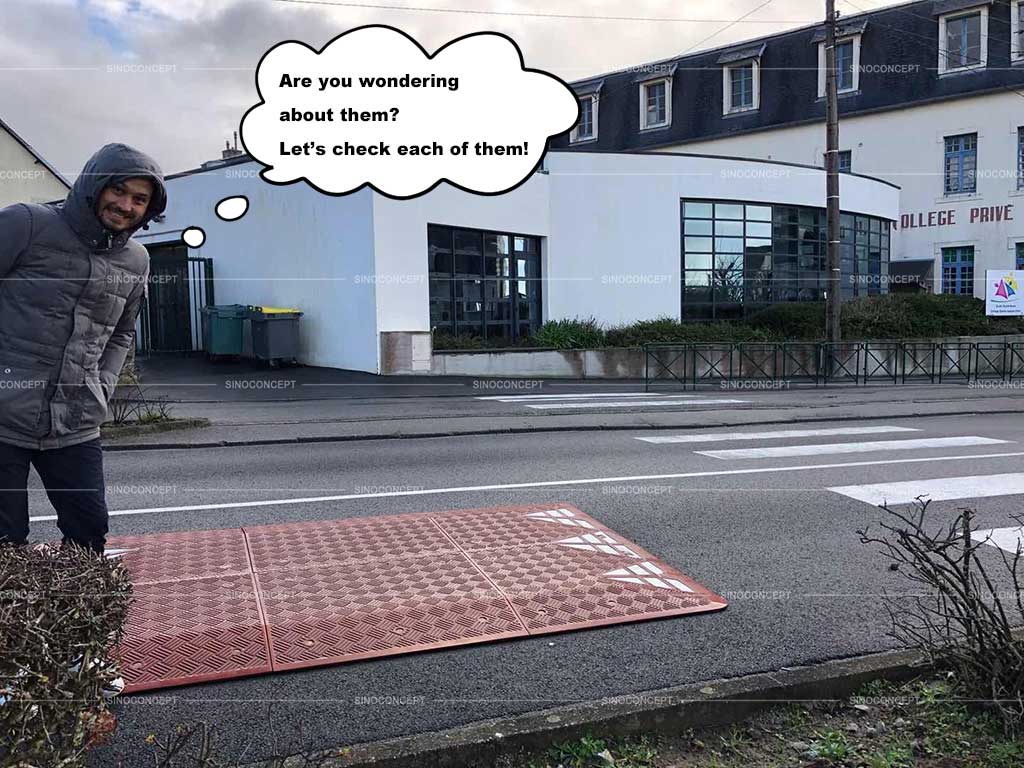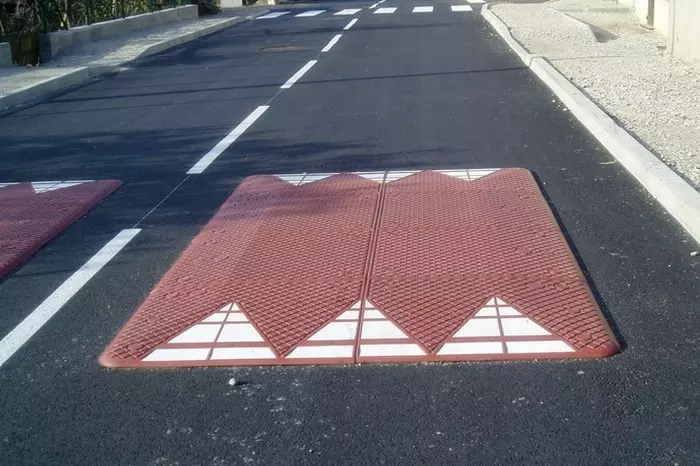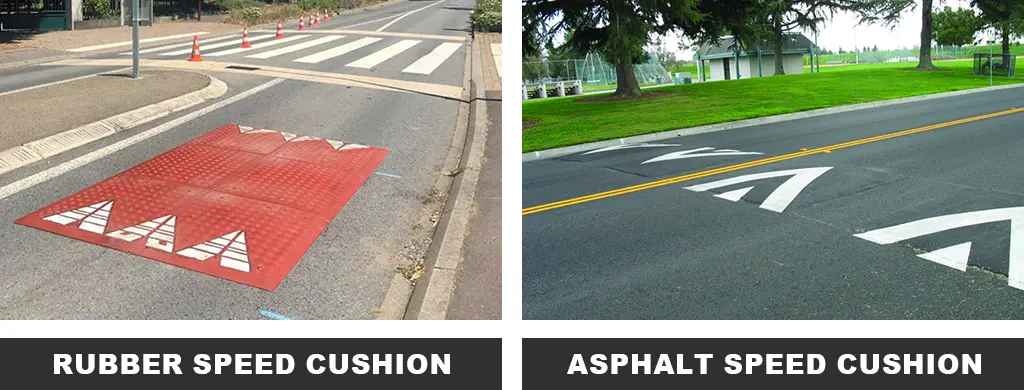Are speed cushions the only way to calm traffic?
Most people think that only speed bumps are the appropriate and only traffic measure. However, it’s not true.
Recently, transportation engineers have implemented many new traffic calming strategies because people fail to obey traffic laws. There have been various variants of speed bumps, including road humps, ramps, and speed tables.
A tremendous variant and vertical reflective speed reduction device produced was speed cushions. Speed cushions are much like traditional speed bumps or road humps. The only difference is that they are installed within gaps for the smooth transmission of emergency vehicles.
They are a special traffic measure type and are widely used globally. According to one study, speed cushions can reduce accidents by up to 40%, which is quite impressive because they can alert drivers to drive at low speeds.
But they are not the only way to calm the traffic. Many traffic control devices are alternatives to speed cushions and speed breakers that can work collectively and improve traffic safety.
Are you wondering about them? Without any further ado, let’s check each of them.
Do you want to know more about this topic? We also have an article talking about the best traffic calming strategies in Europe.

Competitive alternatives to speed cushions!
There are many alternatives to speed cushions:
- Speed tables
Starting off, speed tables give the most breeze-to-speed cushions. However, both serve different purposes. Speed tables are more common on highways because they are often low and aim to make the drivers. Similarly, speed cushions can also be high or low, but their gaps can help emergency vehicles drive without disruption.
- Raised crosswalks
Raised crosswalks increase road heights by 3-6 inches at midblocks or intersections. Therefore, this ensures pedestrian safety and alerts motorists to control their speed.
- Curb extensions
This is another competitive horizontal traffic calming solution. It involves narrowing the streets by installing curbs, trees, plantations, bollards, and sidewalk extensions.
Therefore, it gives less room for motorists to speed. Rumble strips are another curbing way to create visual awareness, leading to fewer collisions and fatalities.

- Chicanes
Another horizontal deflection method involves disrupting the road design and creating alternative extensions, which makes driving difficult. As a result, drivers are forced to lower their speed.
- Roundabouts and traffic circles
A roundabout is a median island in the middle of an intersection. They are installed in city streets and municipalities, reducing traffic volume, congestion, and possible discomfort.
- Signages
One of the most underrated and effective strategies is implementing signage, including stop signs, speed limit signs, road signs, parking signs, traffic signs, hazards, and regulatory signs. They can alert the driver beforehand, making drivers take corrective action.

You have already read a good part of this article, 👀
We've
got the impression that you like it. 🙂
👇🏻
IF YOU ARE LOOKING TO WORK DIRECTLY WITH A MANUFACTURER,
FEEL FREE TO CONTACT US. WE ARE VERY HAPPY TO HELP!
Speed cushions vs speed bumps: which one is the best?
The argument is interesting and can go on. Simply put, both speed cushions and speed bumps are vertical deflection methods.
Speed bumps cover the entire road lane and are quite high, resulting in a very aggressive impact on the vehicle. It can cause people to substantially decrease their vehicles’ miles per hour (mph). On the other hand, speed cushions are speed bumps that are installed in gaps.
You must have seen several speed bumps on the roads with a slight gap between each other. Those types of vertical deflections are speed cushions. The height can be similar to the speed humps or high, like the speed bumps.
Both of the traffic measures are similar with a minute difference. Since speed cushions are installed in gaps, the purpose of the gaps is to avoid disturbing emergency vehicles with wide wheelbases, including fire trucks, police vans, and ambulances.
Since the response time is crucial for these vehicles, it’s imperative to consider these factors when installing a traffic management system. Speed cushions best acknowledge this factor; many emergency vehicles drive without disruption.
However, there is a contention that speed cushions can be less aggressive, and automobiles may go fast over them, making them unsafe. Some bicyclists may even avoid them. Speed cushions may act as bike lanes because bicyclists can use their bicycles to escape easily.
In this contention, speed bumps win because they are high and cause an abrupt speed reduction.
Conclusively, both of the traffic calming solutions are great in their own way. To look closer, speed cushions work better because they consider the emergency response time.

Can speed cushions damage your vehicle?
As mentioned earlier, there is little to differentiate between speed cushions and speed bumps. Therefore, their effects on the vehicle will be the same.
Starting off, speed bumps can affect the suspension of vehicles. The same is true for speed cushions. If you continuously drive at a dynamic speed without considering the impact of speed cushions, you’re slowly destroying your vehicle’s suspension.
Therefore, this is a disadvantage of speed cushions because it slowly deteriorates your vehicle.
All vehicle’s road springs are different, and if you exert more compression on them, there’s a likely chance that your vehicle might go through a suspension malfunction.
Similarly, the shock system might be interrupted due to constant vibrations and movements. If you drive too fast over a speed bump, your vehicle might not absorb the shock, causing leakage in the car’s hydraulic.
Plus, your wheeling alignment can also suffer due to the malfunction of the shock system. It can cause your vehicle to move out of the way due to misalignment. Therefore, speed cushions can have the same repercussions as speed bumps and may cause damage to your vehicle if you don’t care.
Also, tires may suffer and get damaged. Therefore, you should always be careful when driving over any speed cushion. They have very little impact, but if you don’t notice, the less impact might develop into something much worse, which you don’t want to witness.

Differences between recycled rubber and asphalt speed cushion
Recently, transportation engineers have shifted to more environmentally friendly materials for speed cushions. Previously, most of the speed cushions were made from asphalt. They were pretty popular, but they had high maintenance costs.
Shortly after, recycled plastic and rubber became more common for speed cushions. Rubber was more successful because it was recycled, reducing many problems in asphalt speed bumps.
Some of the main differences between asphalt and rubber speed cushions are as follows:
- Firstly, you can’t easily replace an asphalt speed cushion because it is cemented and part of the road lane. On the contrary, recycled rubber speed bumps are replaceable because they are installed through bolts, making their replacement easier.
- Secondly, the vibration noise is reduced by rubber speed cushions, which is not the case with asphalt speed cushions. Therefore, rubber speed cushions are suitable in residential areas where property owners don’t like disturbance due to vehicles.
- Moreover, there is a high maintenance cost with asphalt speed cushions. You have to get an engineering team for installation, which can take up to three days to install. However, you can install a rubber cushion yourself within an hour. Therefore, you can avoid possible street closure and high labour costs.

Conclusion
As mentioned earlier, there has been a revolutionary change in the mechanics and inventions in calming traffic measures. So, speed cushions are not the sole traffic calming measure.
They are, without any doubt, very effective at achieving their purpose. However, they can better achieve their goals when used with multiple measures, including vertical and horizontal deflection systems mentioned earlier.
Authorities like the Department of Transportation, Federal Highway Administration, and Vision Zero aim to reduce traffic congestion and increase pedestrian safety. There can be a menace due to a lot of vehicles gathering around. Therefore, at this time, it is of utmost importance.
If you’re a state officer or traffic in charge and want to reduce traffic congestion’s adverse impacts, then you’re at the right place.
Sino Concept can help you find dazzling measures and solutions to your problems. Visit our website to find measures according to your preferences.
👇🏻
IF YOU ARE LOOKING TO WORK DIRECTLY WITH A MANUFACTURER,
FEEL FREE TO CONTACT US. WE ARE VERY HAPPY TO HELP!





















